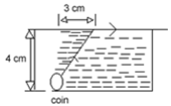 Multiple Choice Questions
Multiple Choice QuestionsA lens having focal length f and aperture of diameter d forms an image of intensity I. The aperture of diameter d/2 in the central region of the lens is covered by a black paper. Focal length of lens and intensity of image now will be respectively
f and 1/4
3f/4 and 1/2
f and 3I/4
f and 3I/4
A ray of light is incident on a 60o prism at the minimum deviation position. The angle of refraction at the first face (ie, incident face) of the prism is
zero
30o
45o
45o
Two thin lenses of focal lengths f1 and f2 are in contact and coaxial. The power of the combination is




A small coin is resting on the bottom of a beaker filled with a liquid. A ray of light from the coin travels up to the surface of the liquid and moves along its surface (see figure). 
How fast is the light travelling in the liquid?
1.8 x 108 m/s
2.4 x 108 m/s
3.0 x 108 m/s
3.0 x 108 m/s
The frequency of a light wave in the material is 2 x 10 Hz and wavelength is 5000 A. the refractive index of material will be:
1.40
1.50
3.00
3.00
A microscope is focussed on a mark on a piece of paper and then a slab of glass of thickness 3 cm and refractive index 1.5 is placed over the mark. How should the microscope be moved to get the mark in focus again?
1 cm upward
4.5 cm downward
1 cm downward
1 cm downward
A convex lens and a concave lens, each having same focal length of 25 cm, are put in contact to form a combination of lenses. The power in diopters of the combination is
25
50
infinite
infinite
If θ1 and θ2 be the apparent angles of dip observed in two vertical planes at right angles to each other, then the true angle of dip θ is given by
cot2θ = cot2θ1+ cot2θ2
tan2θ = tan2θ1+ tan2θ2
cot2θ = cot2θ1– cot2θ2
cot2θ = cot2θ1– cot2θ2
The ratio of resolving powers of an optical microscope for two wavelengths λ1 = 4000 Å and λ2 = 6000 Å is
8 : 27
9:4
3:2
3:2
A beam of light from a source L is incident normally on a plane mirror fixed at a certain distance x from the source. The beam is reflected back as a spot on a scale placed just above the source L. When the mirror is rotated through a small angle θ, the spot of the light is found to move through a distance y on the scale. The angle θ is given by
y/2x
y/x
2y/x
2y/x
